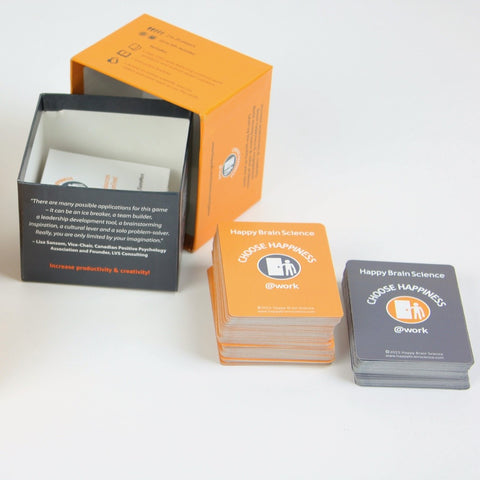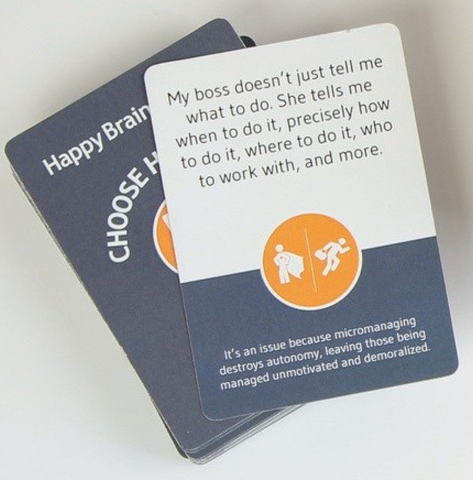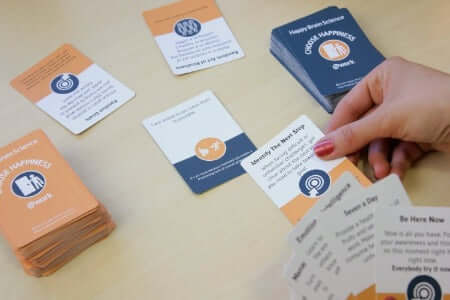Creative Workshop Exercises: Easy and Engaging Activities #8: Solving Work Problems with Positive Psychology
Impact: Team Problem-Solving and Improvements in Motivation, Morale and Wellbeing
Materials Needed: One Choose Happiness @ Work game pack per group of 8 people
Tables suitable for groups of 8 players.
Remember, should you decide to buy one or more sets of the game, you can get 10% off your first shop order with a newsletter subscription
Professional Use: Team Development, Management Development, Positive Psychology Teaching, Leadership Development
You can download this blog here
Who is Solving Work Problems with Positive Psychology for?
This fun and engaging exercise uses the learning from positive psychology to address workplace challenges. The Happiness @ Work game is packed with scientific knowledge of the small things that make a big difference to wellbeing at work. With these tools in their hands, participants learn how to deal with common workplace problems and frustrations in an active, enjoyable way.
How does it help with Motivation, Morale, Well-being and Problem-Solving?
Playing the game requires people to read and think about how key activities from positive psychology apply to various workplace challenges. The game itself boosts wellbeing and morale as it is enjoyably competitive and great fun. Gales of laughter usually accompany the game. At the same time people learn about resourceful ways to manage their own wellbeing, improving their future problem-solving ability. People usually leave motivated to be more pro-active in managing their experiences at work.
How to conduct a Happiness at Work Game Session
Preparation
- If you have plenty of time you can use all the cards in the box (see some suggestions under ‘variations’ at the end of the exercise explanation)
- If you have a limited time, say 40 minutes or less, then I would suggest removing the: Create Your Own Solution Cards, the Free Choice Problem Cards and the Card Categories Cards. This will leave you with a pile of Problem Cards and a Pile of Answer Cards
- I am going to explain how to run a short session which is easily incorporated into other training events. It is a great session to run as an energy-booster or at the end of an intense session for a bit of educational relaxation.
My experience has been that people find the problems on the problem cards very relatable to their experience at work. Very often people pick up a card, read it out and say, ‘actually, this is exactly my problem’.
Setting Up to Play
Explaining the game
It is suggested you explain how it works to the whole large group before dividing it into sub-groups with a pack each.
Initial set up
Explain that
- There are a series of problem cards (the dark grey cards). These are to be placed face down on each group table in a pile in front the player who will start the game.
- There are a series of solution cards (the orange cards). These are to be shuffled, then dealt 7 to each player, face down. These are ‘private’ to each player.

- The remaining solution cards are placed in a pile face down in the middle of the table
First round of play
- Someone is nominated as the first player. They take the first card off the problem pile.

- They read out the problem, possibly adding the bit at the bottom of the card about why it’s a problem, or adding their own views of why it is a problem
- Each other player then looks at their seven cards in their hand. Their task is to pick, from their hand, the ‘best fit’ solution to the problem.


- Each player in turn offers their solution to the person with the problem. They are competing with other players to present the best solution.
- Once everyone has presented their proposed solution, the player with the problem selects the solution they think is best
- They explain why they chose this solution, then hand the problem card to the ‘best solution card’ winner. He or she keeps both these cards as a ‘trick’. They have won this round of play, and the 2-card trick they now have is a record of their win. These cards are set aside at the winner’s elbow
- All the ‘used’ solution cards are returned to the bottom of the solution card pile
- A new player picks a problem card
- The player without solution cards gets dealt their seven so that they can take part in the next round
- Everyone else also gets dealt another card to make their hand up to seven
Additional points
- At each round people with solution cards can exchange all or some of their cards for new ones, but they forfeit the right to offer a solution in that round
- The person picking a problem card is allowed to pick and discard up to two cards if they don’t like them, but must, in that case, stick with their third upturned card.
- If you have a longer time, then it can be interesting to shuffle the Create Your Own Solution Cards and the Free Choice Problem Cards in the appropriate piles. If they turn up in play, then the player is free to make up their own problem or solution.
- Some of the solution cards have the instruction ‘Try it now’ on them. These are usually very quick things everyone in the group can try out right there and then.
To continue the game
- Play rounds for as long as you have time, ideally making sure each player has a go being the person with the problem
- The person with the most ‘tricks’ at the end wins
To enhance the game
The game is really a simple game based on the idea of tricks and trumps. It doesn’t take people long to get the hang of it. However, with very task focused groups, it can become a bit functional.
To maximise the elements of fun and competition, I usually encourage people not just to read their solution card but to actively ‘sell’ it to the problem-holder. So they become emotionally invested in the activity. I say something like, ‘You want to win this trick, you want them to choose your solution, how imaginative can you be in selling it as the best solution? Don’t be shy! Sell it to them!’
Once people get into the spirit of it, I find they are highly creative about the benefits of the proposed solution, which usually creates a lot of laughter and friendly competition.
To enhance the learning
It’s really down to you as a facilitator how much you draw out the learning.
- Each solution card has a brief explanation of how the solution helps create a beneficial outcome

- You can direct people to this information to help them make their ‘case’ for their particular solution.
- In addition, when solutions are proposed, you can ask supplementary questions about how frequently how organizations encounter the particular problem, how it is usually responded to, how the proposed solutions would have a different affect, how easy or difficult it might be to implement and so on.
- And of course, by exploring the solution effectiveness explanations at the bottom of the solution cards, you can bring in additional information about the science or research behind the proposed solutions
Additional uses of the cards
There are many other ways of using these cards.
Finding Solutions to an Actual Problem
- Select the problem card that is about the issue the team or organization is actually dealing with. Split the whole solution pack between the group and get them to select ideas they think really might help.
- Create a statement of an organisational or team issue that needs addressing. Create a process, such as above, for enabling people to sort through potential solutions
Focussing on improving a particular area of organisational life
The solution cards are coded as belonging to one of four areas of intervention
- Practical Positivity
- Subdue Stress
- Flow to Goals
- Revitalize Relationships
This means, for instance, that if you particularly want to focus on relationships within a team, you can work just with the solution cards in that subset.
Five Ways to Improve My Life
- Spread the solution cards out and ask people to pick five activities that they think will improve their life. Once everyone has their cards (or each better, do it sequentially so everyone gets the full selection to choose from) ask them to explain their choices, why they are meaningful to them, and how they propose to put them into practice
I have found this game to be a great hit whenever I have used it in a training session. It is a great way to get ‘positive psychology’ into the conversation without giving a lecture about it!
As you can see from above they are incredibly versatile, especially in the area of improving wellbeing.
The Happiness at Work Game featured here is available at the Positive Psychology Shop. A discount of 10% is available to new newsletter subscribers
If you have any queries about the exercises as described, please contact Sarahlewis@acukltd.com. We will publish any queries and answers in the next shop newsletter to the benefit of all.
Please feel free to share the link to this page with any colleagues you feel may be interested. Or, direct them to the newsletter subscription page where they can find out about the newsletter service and subscribe for free.
Please also feel free to add a link to this blog and/or our shop to your website if you think it might add value to your website visitors.

